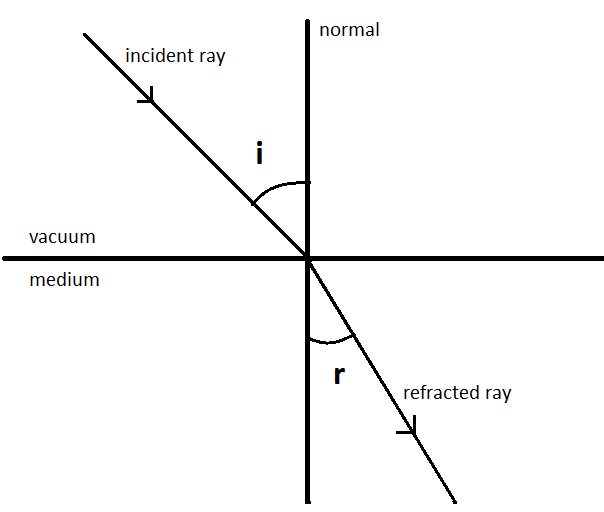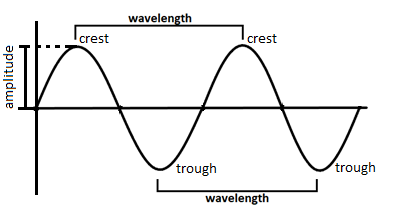
What is the relation between Wavelength and Refractive index.
Answer
510.6k+ views
Hint: In order to answer the above question, we will first define the term wavelength and refractive index. We will also write the equation for the following. We will understand the terms and try to find the relation or an equation connecting these two terms.
Complete step by step solution:
As we all know, the bending of a ray of light as it passes through one medium and through another is measured by the refractive index, also known as the index of refraction. If $i$ is the angle of incidence of a ray in vacuum (the angle between the incoming ray and the natural, which is perpendicular to the surface of a medium), and $r$ is the angle of refraction (angle between the ray in the medium and the normal), The refractive index $n$ is equal to the ratio of the sine of the angle of incidence to the sine of the angle of refraction; in other words,
$n=\dfrac{\sin \left( i \right)}{\sin \left( r \right)}$

The refractive index can also be stated as the velocity of light $c$ of a given wavelength in empty space divided by the velocity of light $v$ in a material,
$n=\dfrac{c}{v}$
Now, the wavelength of a wave is the distance between consecutive crests, especially the points of an electromagnetic wave. Wavelength and frequency are inextricably linked. The shorter the wavelength, the higher the frequency. Since all light waves travel at the same speed through a vacuum, the number of wave crests moving by a given point per second is determined by the wavelength.

The Wavelength is represented by the symbol $\lambda $. Any wave's Wavelength Formula is given by
$\lambda =\dfrac{v}{f}$
The wavelength is measured in metres, the velocity is measured in metres per second, and the frequency is measured in hertz.
Now, if we look at both the formulas, i.e., the formula of the refractive index of a material and the formula of the wavelength, we can write
$\lambda =\dfrac{c}{nf}$ because $\left[ n=\dfrac{c}{v} \right]$
Therefore, we can conclude that the wavelength is inversely proportional to the refractive index of the material in which the wave is travelling.
Note:
It is very important to note here that the frequency of the wave will also change inversely to the wavelength. If the wavelength of the wave is shortened, it implies that the frequency will be increased as the number of cycles completed in a unit interval of time will be increased.
Complete step by step solution:
As we all know, the bending of a ray of light as it passes through one medium and through another is measured by the refractive index, also known as the index of refraction. If $i$ is the angle of incidence of a ray in vacuum (the angle between the incoming ray and the natural, which is perpendicular to the surface of a medium), and $r$ is the angle of refraction (angle between the ray in the medium and the normal), The refractive index $n$ is equal to the ratio of the sine of the angle of incidence to the sine of the angle of refraction; in other words,
$n=\dfrac{\sin \left( i \right)}{\sin \left( r \right)}$

The refractive index can also be stated as the velocity of light $c$ of a given wavelength in empty space divided by the velocity of light $v$ in a material,
$n=\dfrac{c}{v}$
Now, the wavelength of a wave is the distance between consecutive crests, especially the points of an electromagnetic wave. Wavelength and frequency are inextricably linked. The shorter the wavelength, the higher the frequency. Since all light waves travel at the same speed through a vacuum, the number of wave crests moving by a given point per second is determined by the wavelength.

The Wavelength is represented by the symbol $\lambda $. Any wave's Wavelength Formula is given by
$\lambda =\dfrac{v}{f}$
The wavelength is measured in metres, the velocity is measured in metres per second, and the frequency is measured in hertz.
Now, if we look at both the formulas, i.e., the formula of the refractive index of a material and the formula of the wavelength, we can write
$\lambda =\dfrac{c}{nf}$ because $\left[ n=\dfrac{c}{v} \right]$
Therefore, we can conclude that the wavelength is inversely proportional to the refractive index of the material in which the wave is travelling.
Note:
It is very important to note here that the frequency of the wave will also change inversely to the wavelength. If the wavelength of the wave is shortened, it implies that the frequency will be increased as the number of cycles completed in a unit interval of time will be increased.
Recently Updated Pages
Two men on either side of the cliff 90m height observe class 10 maths CBSE

What happens to glucose which enters nephron along class 10 biology CBSE

Cutting of the Chinese melon means A The business and class 10 social science CBSE

Write a dialogue with at least ten utterances between class 10 english CBSE

Show an aquatic food chain using the following organisms class 10 biology CBSE

A circle is inscribed in an equilateral triangle and class 10 maths CBSE

Trending doubts
Why is there a time difference of about 5 hours between class 10 social science CBSE

Write a letter to the principal requesting him to grant class 10 english CBSE

What is the median of the first 10 natural numbers class 10 maths CBSE

The Equation xxx + 2 is Satisfied when x is Equal to Class 10 Maths

Which of the following does not have a fundamental class 10 physics CBSE

State and prove converse of BPT Basic Proportionality class 10 maths CBSE




